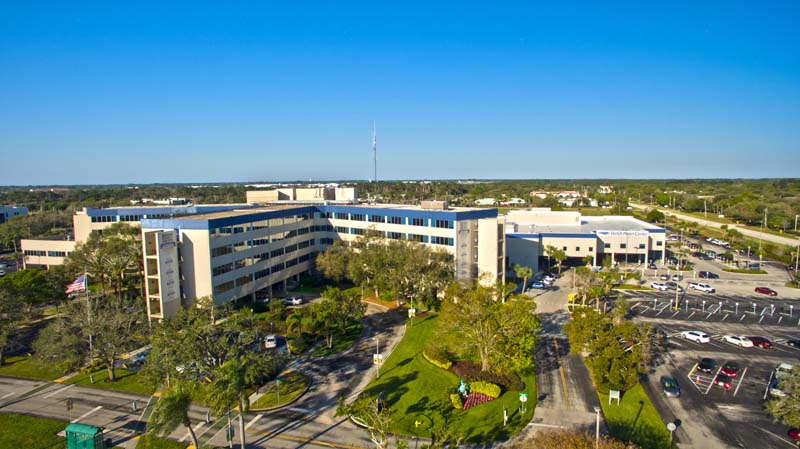It was Day 37 of the Cleveland Clinic/Indian River Medical Center merger and if anyone was wondering who’s counting, Dr. Gregory Rosencrance made it clear: He is.
In an hour-long, town-hall style presentation at Quail Valley’s River Club last week – the 14th such presentation he has given – the new president of Cleveland Clinic Indian River discussed the many tasks involved and the progress made so far in integrating an 86-year-old small-town community hospital into one of the top healthcare systems in the world.
Among other things, he talked about how joining Cleveland has already benefited healthcare at Indian River, how Cleveland evaluates doctors and the future of medical education at the hospital here.
“What happened Jan. 1 was about a seven-fold expansion of beds” in Cleveland’s Florida network, Rosencrance said, as a map of the state peppered with dots flashed on a screen to indicate Cleveland Clinic’s creep along Florida’s east coast.
“We’re big, and we want to be big, but we want to act small,” he said. “Healthcare is a one-on-one, individual endeavor.”
Already, the benefits of being part of a system rather than a stand-alone hospital are becoming obvious. “Last week, there was a shortage here of a certain medication that Weston had plenty of,” said Rosencrance. “It was shipped up here, and in two-and-a-half hours, we no longer had a shortage.”
Another shortage in Florida, this time a certain type of pressure transducer: “We were told it won’t be available on the market until March. They were flown in from Cleveland the next day.”
Soon, the Duke University-affiliated heart program at what was Indian River Medical Center will be shifting to an affiliation with Cleveland Clinic’s Heart and Vascular Institute, ranked No. 1 in the world.
The cancer center, too, will make the transition, after a six-month “lag,” as Rosencrance put it. He said patients involved in research protocols would be getting a letter this week regarding the transition.
He also spoke to the audience of almost 200 about the public’s impression that Cleveland’s model of care requires all physicians working at the hospital to be employed by Cleveland Clinic. “That is very true at the Weston campus, and it’s very true at the downtown Cleveland Clinic campus,” he said, but at 14 regional hospitals in northeast Ohio, “it’s about a 50-50 mix of employed and private physicians.
“Those of you that have physicians that are private, as long as we’re aligned in quality goals, safety goals and those things, we embrace that.”
Rosencrance went on to outline the process for evaluating physicians, including patient experience scores on post-treatment surveys, and keeping track of data on key metrics such as rates of infection.
There is also an annual review process for every employed physician, a task that in his former position as head of the Medicine Institute in Cleveland involved sitting down individually each year with more than 500 doctors. Those sessions cover not only scores and measures but physician burn-out. “We’ll have a pretty significant rigor with how we evaluate everyone,” he promised. “We’re not there yet, but it’s Day 37.”
Rosencrance said teams are arriving in March to study the emergency department, currently contracted out to Envision, a national chain. Presumably those teams will be looking for ways to reduce ER wait times and improve care, among other tasks.
In response to a question from a young couple in the Quail Valley audience, Rosencrance said pediatric emergency care will be one of the topics the teams will examine. Currently, Lawnwood Regional Medical Center in Fort Pierce is the only nearby hospital fully equipped to deal with pediatric emergencies.
He said there is an “opportunity” to upgrade pediatric care here.
Regarding medical education at Cleveland Clinic Indian River, Rosencrance said his team will “explore initially our undergraduate medical education, and we will be exploring graduate medical education [too].”
Prior to the takeover, Indian River announced a significant expansion of its medical education program, which currently amounts to just 15 medical students from the Florida State University College of Medicine Fort Pierce campus.
In November, Dr. George Mitchell was named director of medical education at the hospital in a move seen as laying the groundwork for greater numbers and higher levels of medical education. In another move hinting at future teaching hospital status, Dr. Juliette Lomax-Homier, dean of the Fort Pierce campus of FSU med school, was named to the Cleveland Clinic Indian River board of directors.
“Will you have residency training programs at some point in the future? Yes. It’s not going to happen tomorrow, but the answer is yes. I wouldn’t have come here if I didn’t think that is part of the plan,” Rosencrance said.
As chairman of the Medicine Institute at Cleveland’s main campus in Ohio, Rosencrance oversaw 564 physicians, 260 advanced practice providers, and 216 residents, the largest internal medicine residency program in the nation.
At the campus in Cleveland, he circulated among the leaders of 66,000 employees, 7,000 physicians plus thousands more scientists and researchers.
By contrast, in Vero, he oversees 2,000 employees.
“People ask me, well, golly, why did you come here?” said Rosencrance. “It’s really a once-in-a-generational opportunity. That’s one of the reasons I came. This doesn’t happen too often. To be the best healthcare system in the state and the best healthcare system in the world – that’s a heck of an opportunity.”

